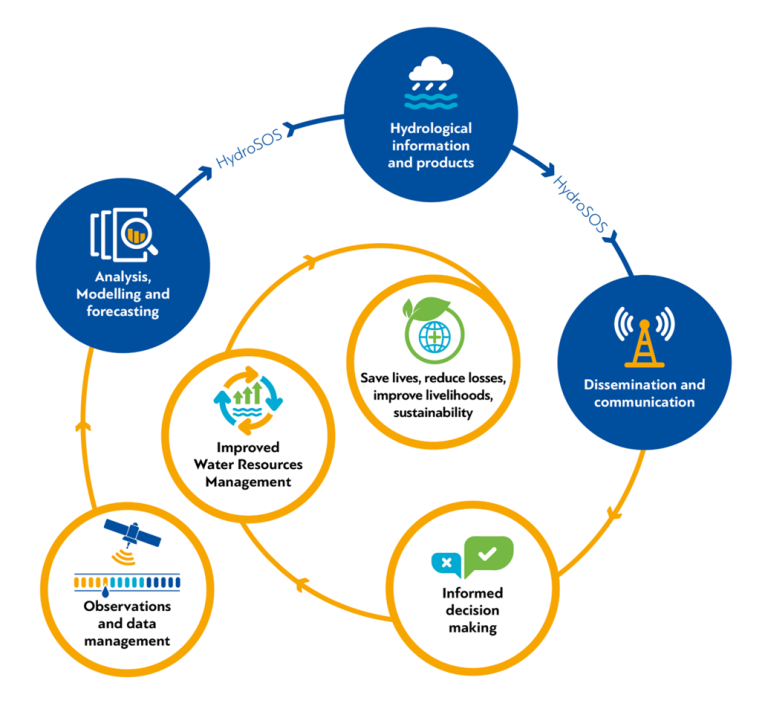Congress strengthens hydrology action

Against a backdrop of increasing hazards like floods and droughts in parts of the world and growing pressure on water resources, the World Meteorological Organization will strengthen implementation of its plan of action for hydrology.
A dedicated two-day Hydrological Assembly took place during the World Meteorological Congress to showcase the central role of hydrology in WMO’s Earth System approach and in the Early Warnings For All initiative.
Congress reinforced its long-term vision for hydrology. It approved strengthened flood forecasting initiatives. It also backed the principal goal of the Integrated Drought Management Programme to develop a global coordination of efforts to strengthen drought-monitoring, risk identification, drought prediction and early warning services. It backed the expansion of the existing HelpDesk on Integrated Flood Management and the HelpDesk on Integrated Drought Management (IDM) to support water resources management in its entirety.
Between 1970 and 2021, flood-related disasters were the most prevalent in terms of frequency. Tropical cyclones - which combine cascading wind, rainfall and flood hazards – were the leading cause of human and economic losses.
Drought in the Horn of Africa, large parts of South America and part of Europe, and devastating floods in Pakistan upended millions of lives last year. Drought turned to deluge in parts of Europe (northern Italy and Spain) and Somalia as Congress took place – again illustrating the increasing intensity of extreme water events in an era of climate change.
Monitoring and management

Currently, 3.6 billion people face inadequate access to water at least a month per year and this is expected to increase to more than 5 billion by 2050, according to WMO’s State of Global Water Resources. Melting glaciers bring the threat of looming water shortages for many millions – and as a result Congress has elevated the changes in the cryosphere to one of WMO’s top priorities.
“Better forecasts and management of water-related hazards are pivotal to the success of Early Warnings for All. We want to ensure that no one is surprised by a flood, and everyone is prepared for a drought,” said WMO Secretary-General Prof. Petteri Taalas. “WMO needs to strengthen and integrate hydrological services to support climate change adaptation.”
A major obstacle to provide efficient and sustainable water solutions is the lack of information about the currently available water resources, future availability and demand for food and energy supply. Decision makers are faced with the same dilemma when it comes to flood and drought risks.
Today, 60% of WMO Member States report declining capabilities in hydrological monitoring and thus in the provision of decision support in the water, energy, food and ecosystem nexus. More than 50% of countries worldwide have no quality management system for their water related data in place.
To meet the challenges, WMO is promoting improved water resource monitoring and management though the Hydrological Status and Outlook System (HydroSOS) and Global Hydrometry Support Facility (HydroHub), which are now being rolled out.
Hydrology Action Plan
WMO has a wide-ranging Hydrology Action Plan, with eight long term ambitions.
- No one is surprised by a flood
- Everyone is prepared for drought
- Hydro-climate and meteorological data support the food security agenda
- High-quality data supports science
- Science provides a sound basis for operational hydrology
- We have a thorough knowledge of the water resources of our world
- Sustainable development is supported by hydrological information
- Water quality is known.
Flash Flood Guidance System
The Hydrological Assembly was also informed about the Female Empowerment workshop organized by WMO in the framework of the Flash Flood Guidance System project on 25 and 26 May 2023.
A selected group of experts from the workshop shared the workshop outputs with the wider hydrological community, including tools to create a network of motivated professional and outstanding experts, to strengthen their capacities, and to develop to their highest potential, not just for their own benefit but to serve societal needs around the world.

Drought
Congress endorsed on proactive, risk management instead of the traditional response to drought through reactive, crisis management. It encouraged Members to promote and enhance cooperation and twinning arrangements between National Meteorological and Hydrological Services and other WMO recognized institutions for improved drought forecasting and monitoring.
It recognized the work of the Integrated Drought Management Programme (IDMP), which is a partnership of 40 organizations, including the Global Water Partnership, Food and Agriculture Organization and the United Nations Convention to Combat Desertification (UNCCD) among the other 40 partners.









